
16 – 29 August 2023
JAGUARS OF BRAZIL’S PANTANAL

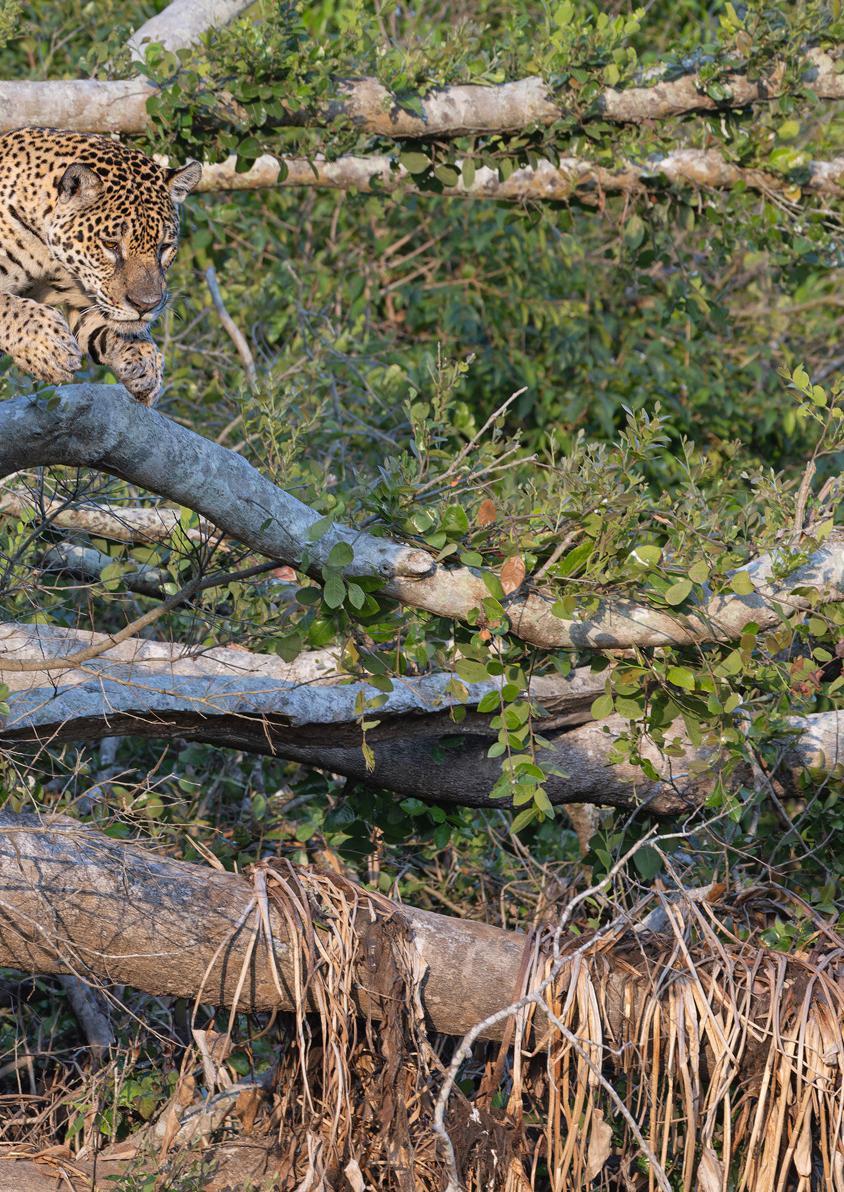
2023 marked the sixth Wild images, ‘Jaguars of Brazil’s Pantanal’ tour, the second since the pandemic lockdowns, and it was very reassuring to see that the Jaguars along the Rio Cuiabá and its tributaries were better than ever. We spent a full six days on the river, taking 12 trips, and spending almost 60 hours mostly in search of them. Our total of 19 Jaguar encounters was a little lower than previously, however, it included such a wide range of behaviour, involving nine individuals and was certainly my best so far. The Jaguar highlights included a caiman kill as well as the much rarer capybara kill and lots of jumping action. There were also opportunities for close portraits in trees; eyelevel stalking and swimming; scenting; against the light shots and in the shadows on the riverbank with nice backgrounds. Better still, many of the encounters were prolonged. There also seemed to be fewer boats on the river this time and we were able to find four Jaguars ourselves. We even ventured downstream from Porto Jofre for the first time on one of my tours and also explored the further reaches of the Rio Piquiri. With some time to scrutinise my images, and with the help of the Jaguar identification project, it was possible to identify all the Jaguars we saw to individuals.
One of the main highlights was the realisation that the caiman killer was, in fact, Patricia, not only the mascot of the Jaguar identification project, but also the main image on the Wild Images website, dating back to our 2015 tour. She was obviously nursing cubs at the time of our visit, incredibly her fifth litter! As always, this tour is not just about Jaguars. We made two stops along the Transpantaneira on our way to Porto Jofre and there is also much to see from the 120km road itself. The charmingly rustic Pouso Alegre lodge delivered two Lowland Tapir encounters, as well as many bird photography opportunities, including point blank Great Rheas, Toco Toucan and Bare-faced Curassow at its bird feeders and both Ferruginous Pygmy and Great Horned Owls in the woodland around the lodge itself. The only negative here was our failure to connect with Giant Anteater, the habituated animal, which the lodge as famous for has not been seen since the lockdown fires of the Covid-19 pandemic and sightings have only just begun to increase again here. Despite a lot of effort, we narrowly missed seeing an anteater a couple of times. The Pink Ipe trees were in full bloom at the time of our visit, and there was a lot of activity around the water holes, although

Wild Images | Jaguars of Brazil’s Pantanal 2023 Page 4
Front Cover: Jaguar ‘Krishna’ drags a Capybara up the riverbank. Next page: Jaguar ‘Medrosa’ dives into a hyacinth bed & this page: Toco Toucan (Mike Watson)
none of it was particularly photogenic, all animals being distant. The Pantanal was still in the grip of a prolonged dry spell, although we did see some signs of this breaking, with some torrential rain at the start of our trip.

SouthWild’s Santa Tereza Lodge went very well, except for the main attraction, Ocelot. Although we saw this gorgeous cat, it failed to visit the main part of the feeding station on both nights of our visit, having been present every night for the previous 15 nights, can you believe that? This was just incredibly bad luck. We still had a great time here, particularly on the three boat trips we made. Santa Tereza is well known for its habituated fish-eating birds along the river, and we were able to capture some great action images of Black-collared Hawk, Cocoi Heron and Ringed Kingfisher, coming to the piranhas, caught by our boatman. Other highlights here included the beauty of the shadows, Agami Heron, as well as Boat-billed Heron, Wattled Jacana and numerous Rufescent Tiger Herons. Santa Tereza also features a superb eye-level Jabiru nest tower, and we were able to spend some time on it in lovely light at sunrise.
The water levels along the Transpantaneira were very low this year, with numerous roadside waterbodies dried up. There were, however, some pools remaining, which were rammed full of birds. We made several stops on our way along the road of 120 bridges, for such as Maguari Stork, Southern Screamer, Capped Heron, Snail Kite, American Pygmy Kingfisher, Great Horned Owl and Hyacinth Macaw. We also usually see something crossing the road and this time the most interesting was a large False Water Cobra. On our way back north at the end of the tour, we added Lesser Tamandua and the incredible Red-legged Seriema to our memory cards.
The Pantanal remains the number one wildlife photo destination in South America by far, in terms of number and accessibility of photogenic animals, and it ranks very highly in world terms. It was particularly nice to see how quickly it has recovered after the pandemic lockdown fires of 2020, very little evidence of which can now be seen.
Mike Watson, Clitheroe August 2023
Pink Ipe tree on the Transpantaneira (Mike Watson)

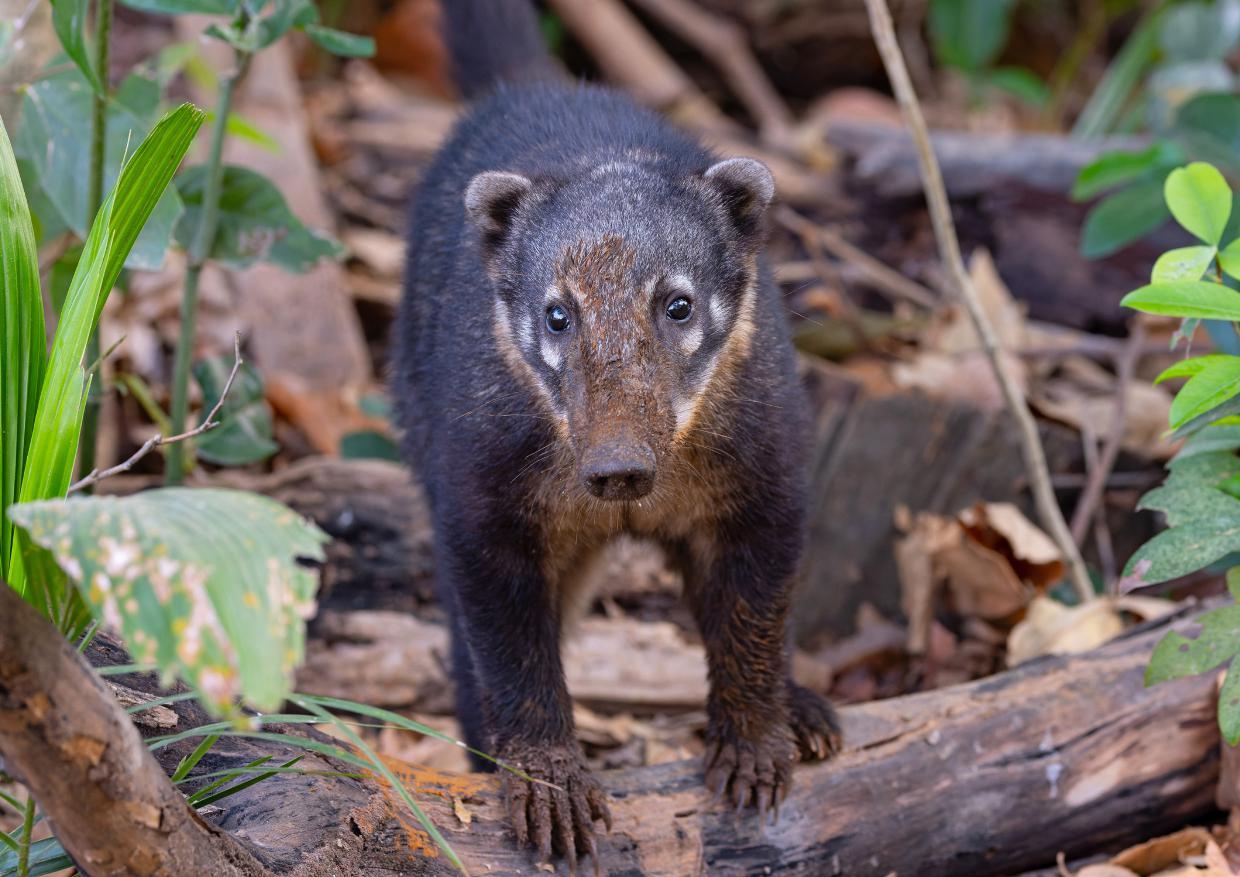
Our 2023 tour began as usual at Cuiabá airport, in its twin city of Varzea Grande. Once gathered, we were soon off in our brand-new Mercedes Hi-line Sprinter van, bound for the Pantanal, passing through the seemingly endless dry Cerrado countryside. It became clear that there had not been much rain here for a while. The atmosphere was hazy and many water courses were dry. Eventually, we reached the small town of Pocone, gateway to the Pantanal. Once a centre for trade in alligator and Jaguar skins, this small town is now bedecked with colourful wildlife murals and sculptures, marking its importance as a centre for ecotourism. Many of the folks who look after us down on the river live in Pocone. Without a cloud in the sky, and the temperature at midday approaching 40 degrees, we continued fairly quickly to our first destination, Pouso Alegre. We did have time to make a quick stop at a roadside Great Potoo, sitting on its nest, although light conditions were far from ideal. We also passed many characteristic birds of the Pantanal along the way, seeing our first Jabiru, rhea and Roseate Spoonbills, although in the harsh light, we decided not to pause for a photo. There would be plenty of time later! After lunch we settled into our new surroundings at Pouso Alegre, and made an afternoon drive, exploring the remote water holes of this 30,000-hectare property. Thanks to the ongoing drought there was a lot of activity at the water holes, although most of it was a little out of reach of our cameras, numerous Chaco Chachalacas, White-throated and Red-throated Piping Guans and Undulated Tinamous visited, and, as dusk approached, we enjoyed small groups of South American Coati and Collared Peccaries, as well as a few Red Brocket Deer. A couple of Blackand-white Tegu lizards also passed by but not within camera range. After evening meal, we made another night drive, scoring a young tapir on the track between the water holes after 9.30pm. Unfortunately, the amount of dust in the air was such that flash photography was impossible. Nevertheless, we did manage to photograph its three toes (it is the only ungulate with three toes).


Wild Images | Jaguars of Brazil’s Pantanal 2023 Page 7
Lowland Tapir & South American Coati, Pouso Alegre (Mike Watson)
Next morning, we made a pre-breakfast night drive to the waterholes, but did not connect with the hoped-for anteater. We did manage five Crab-eating Foxes and more of the same animals from the previous afternoon. After breakfast is the time to check the bird feeders, before the strong sunlight becomes too harsh and there was a great variety of birds visiting the feeders, which are supplied by kitchen leftovers. These included the fantastic Toco Toucan - remember the Guinness advert? The toucan seems to be very fond of mango pieces, although they were quite shy this time and affected by the movement of the photographers. With some perseverance we were able to get some nice images of them in the tree canopy, rather than at the less photogenic feeders. The beauty of Pouso Alegre is that there is much to do within a very short walk of the lodge buildings, a welcome break from the endless boat and truck rides elsewhere. A pair of Ferruginous Pygmy Owls was present near

Wild
|
Page 8
Images
Jaguars of Brazil’s Pantanal 2023
Ferruginous Pygmy Owls, Pouso Alegre (Mike Watson)
the horse pens, this is still a working Fazenda. A striking Amazon Whiptail lizard paused for a while, in the leaf litter by the kitchen, and several Fringe-lipped Bats could be photographed in the tool shed by the horses.
In the afternoon we made an excursion to the Rio Bento Gomes channel forest trail seeing many open country birds enroute, including Savannah Hawk, Plumbeous Ibis and Southern Lapwing, although the trail itself was disappointing in terms of animals. A Black-andgold Howler Monkey and a mating pair of Hyacinth Macaws occupied us on the return. Another night drive after evening meal produced a Great Horned Owl, Great Potoo, numerous pauraques, another four Crab-eating Foxes and some Red Brocket Deer, but again no Giant Anteater. Next morning came news of an anteater, the previous night, which we had missed by only 30 minutes, so we decided to follow up this sighting. Unfortunately, the anteater had moved on and even had the temerity to appear in the spot I had originally planned to check this morning. The pre-breakfast walk produced some nice photo opportunities of common birds and another couple of foxes.

Wild Images | Jaguars of Brazil’s Pantanal 2023 Page 9
Greater Rhea, Pouso Alegre (Mike Watson)
Eventually, it was time to say farewell to Pouso Alegre and head south, although we did swing by its southern cow pastures, on a last-ditch anteater mission, adding the Smart Aplomado Falcon to our list of birds. Driving south towards Santa Tereza, the Cambara, Pink Ipe and Yellow Ipe trees were particularly nice against a dark, stormy sky. We also had a great encounter with Great Black Hawk pair in a Yellow Ipe tree, as well as a very close Roadside Hawk along the Transpantaneira. All of the bridges to this point are now concrete and steel constructions and gone are the days of 120 rickety wooden bridges. Only a few remain between Rio Pixaim and Porto Jofre for aesthetic reasons. The journey is therefore much quicker but now even more dusty thanks to the speeding traffic.
The SouthWild Lodge at Santa Tereza is beautifully located on the banks of the Rio Pixaim, set in rough Savannah/cowpasture. Our daytime activities here focused on boat trips along the river, all downstream, following the choking of the upstream stretches by Water Hyacinth. The boatmen are incredibly skilled in catering for wildlife photographers. These days they spend their downtime fishing for piranhas, which are then fed to birds along the river, affording some great action shot opportunities. On our first trip, we could photograph Black-collared Hawk, Cocoi Heron and the gorgeous Sunbittern, although we narrow-

Wild Images | Jaguars of Brazil’s Pantanal 2023 Page 10
Amazonian Whiptail, Pouso Alegre (Mike Watson)
ly missed a wings-open shot. Other birds at close range along the river, included the resident pair of Jabirus (which often followed the boat – they get fed as well), Rufescent Tiger and Little Blue Herons, Anhinga and Amazon Kingfisher. We also saw Capybara, Azara’s Agouti, Yacare Caiman and Green Iguana. As dusk falls, it is time to head to the ocelot feeding station but I will not dwell too much on this, other than to say it did not show up tonight. Interestingly, a Great Antshrike has discovered the Ocelot’s food and seems to visit every night for its supper!
Our early morning boat trip started before dawn with a nice adult Boat-billed Heron, to test our night photography skills and, soon after dawn, we followed this up with a Sungrebe and then the much sought-after ‘Soco Beija Flor’, also known as Agami Heron. ‘Soco’ means punch, a name given to several herons owing to their method of catching fish and ‘Beija Flor’ means Flower-kisser, the Portuguese for hummingbird, on account of the heron’s hummer-like plumage, so ‘Hummingbird Heron’ it is then. It was only a few metres from the Sungrebe, and was a happy by-product of the former sighting. As always, the most beautiful of all herons
 Agami Heron, SouthWild Santa Tereza. Next page: Boat-billed Heron & Black-collared Hawk (Mike Watson)
Agami Heron, SouthWild Santa Tereza. Next page: Boat-billed Heron & Black-collared Hawk (Mike Watson)


caused some excitement in the boat, even Dingdong, our boatman had been playing down our chances of this ever-tricky bird. We were able to watch it, as it crept through the dark shadows of overhanging trees by the river, occasionally having to cross an open patch, where our camera shutters whirred. The boat trip also included some more nice encounters with Rufescent Tiger Heron, Black-crowned Night and Cocoi Herons, Amazon and Ringed Kingfishers, as well as a few flyover parrots – notably Golden-collared Macaw. In the afternoon we ventured further downstream in the hope of giant otter. Ultimately this was not successful, although we did manage more nice encounters with tiger herons and Black-collared Hawk, as well as some interesting bird encounters, particularly Helmeted Manakin, although the male of this exquisite species remained out of range of the cameras. This evening, although the Ocelot did turn up at the feeding station, it took a quick look, and disappeared back into the darkness. This occasionally happens, the cause of this odd behaviour is not always known, although the presence of jaguar and/or foxes can be the reason. We did see a couple of Crab-eating Foxes saunter past whilst waiting in vain for the cat. What miserable luck. I’m sure we will see it first try next time, as we have always done in the past.

We spent our final morning at Santa Tereza on its fabulous eye-level Jabiru nest tower. The male and female of the pair were collecting more nest material to further extend the new tier they are adding to their already massive nest, so there were many comings and goings in lovely sunrise light, even allowing opportunities for deliberate motion blurs. The nest has a nice Pink Ipe tree in the background! After another terrific all-you-can-eat Brazilian buffet breakfast we headed further south down the Transpantaneira to Porto Jofre. There were many bird photography opportunities along the way, including: Southern Screamer; Muscovy Duck, the uncommon Maguari Stork, as well as numerous ibises and herons. The lovely Capped Heron obliged for the cameras as did numerous Black-collared Hawks and Snail Kites. The waterbird enthusiasts could photo-

Wild Images | Jaguars of Brazil’s Pantanal 2023 Page 13
graph White-backed Stilt, Southern Lapwing, and Solitary Sandpiper by the roadside. Our regular lunch stop, in a bee-filled copse, added a roosting Great Horned Owl and American Pygmy Kingfisher. We always dream of an anaconda, crossing the road on this journey, as happens from time to time, however, we enjoyed the less frequently seen, False Water Cobra instead this time.
After finally checking in at the Hotel Pantanal Norte at Porto Jofre, we had time for a walk around its grounds. The main attraction here is the population of Hyacinth Macaws, and we were treated to point-blank views of at least 15 of these largest parrots, some of which were feeding in the fruit-laden palms behind our chalets in lovely evening light. The other main feature of the hotel grounds is its lovely lake, however, this was rather dry and many of its famous Victoria Lilies had run aground. We could still find a few interesting birds to photograph here, including Rufescent Tiger
Heron, and Wattled Jacana on the lilies themselves, and an uncommon Pantanal Snipe in the marsh, before the sun fell from the sky. For the next six days, we followed the same routine. An early alarm was followed by a 5am breakfast, after which we boarded our fast motorised skiff and headed upstream on the Rio Cuiabá. The Rio Cuiabá is an 800km slow-flowing, silt-laden river, which ultimately flows south into the River Plate and out into the Atlantic between Uruguay and Argentina. It is joined by the Rio São Lourenço upstream of Porto Jofre and it is above this confluence that most of the Jaguar sightings occur. One of our group had spent three days on the river years ago, without a Jaguar sighting, so it was a great relief to feel Alex open the throttle, only half an hour into our first boat ride. A sudden change of pace is always in response to news of a jaguar sighting over the radio.

Wild Images | Jaguars of Brazil’s Pantanal 2023 Page 14
This page: Cocoi Heron. Next page: Great Black Hawks (Mike Watson)


Wild Images | Jaguars of Brazil’s Pantanal 2023 Page 15

 Hyacinth Macaw. Next pages: Jabirus & Rufescent Tiger Heron (Mike Watson)
Hyacinth Macaw. Next pages: Jabirus & Rufescent Tiger Heron (Mike Watson)





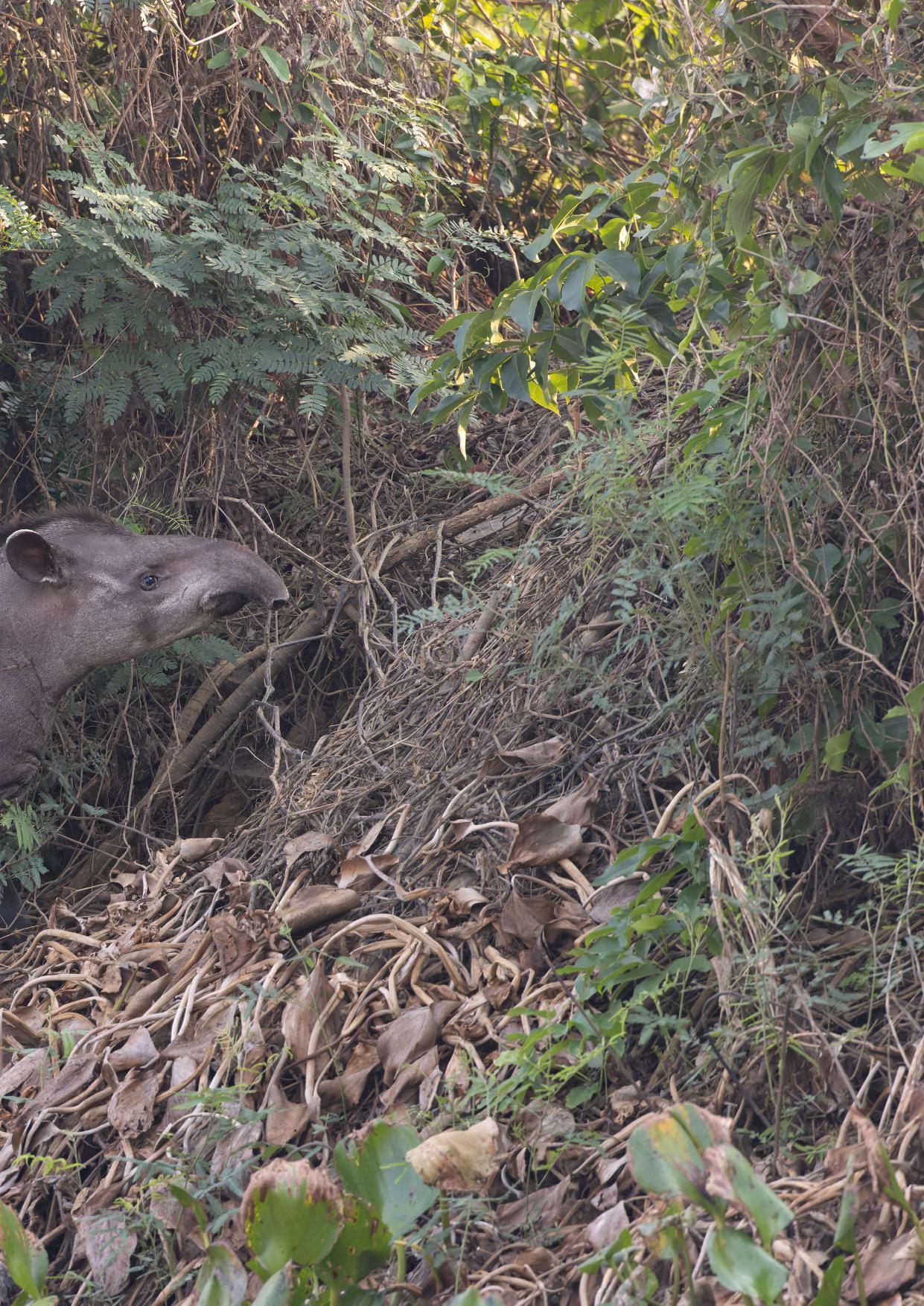 Lowland Tapir, showing the scars of a life on the riverbank (Mike Watson)
Lowland Tapir, showing the scars of a life on the riverbank (Mike Watson)
JAGUARS

JAGUAR NO. #1 - MEDROSA
It is easy to spot a Jaguar, when looking at the boats already assembled, and the direction in which everyone is pointing their cameras. Medrosa is a female Jaguar, the daughter of Patricia, first seen in 2016 (we saw the meeting of her mother and father, Adriano, one of the heaviest Jaguars recorded in the Pantanal on our 2015 visit). Her alternative name, Amber refers to her eye colour, inherited from her mother. She was sleeping on a large, fallen tree on the east side of the channel, in a very photogenic position in lovely, golden dawn light. One of the other guides suggested she was hunting rather than sleeping, and fortunately we kept our concentration and captured her leap into the hyacinth bed in front of our boat. Unfortunately, she missed the caiman she had lined up and she climbed back out of the water onto the bank. We followed her for a while, watching her hunting along the banks of the channel, making another jump, swimming across the channel, climbing another tree and hunting again, until eventually, we lost her in a vast hyacinth bed.


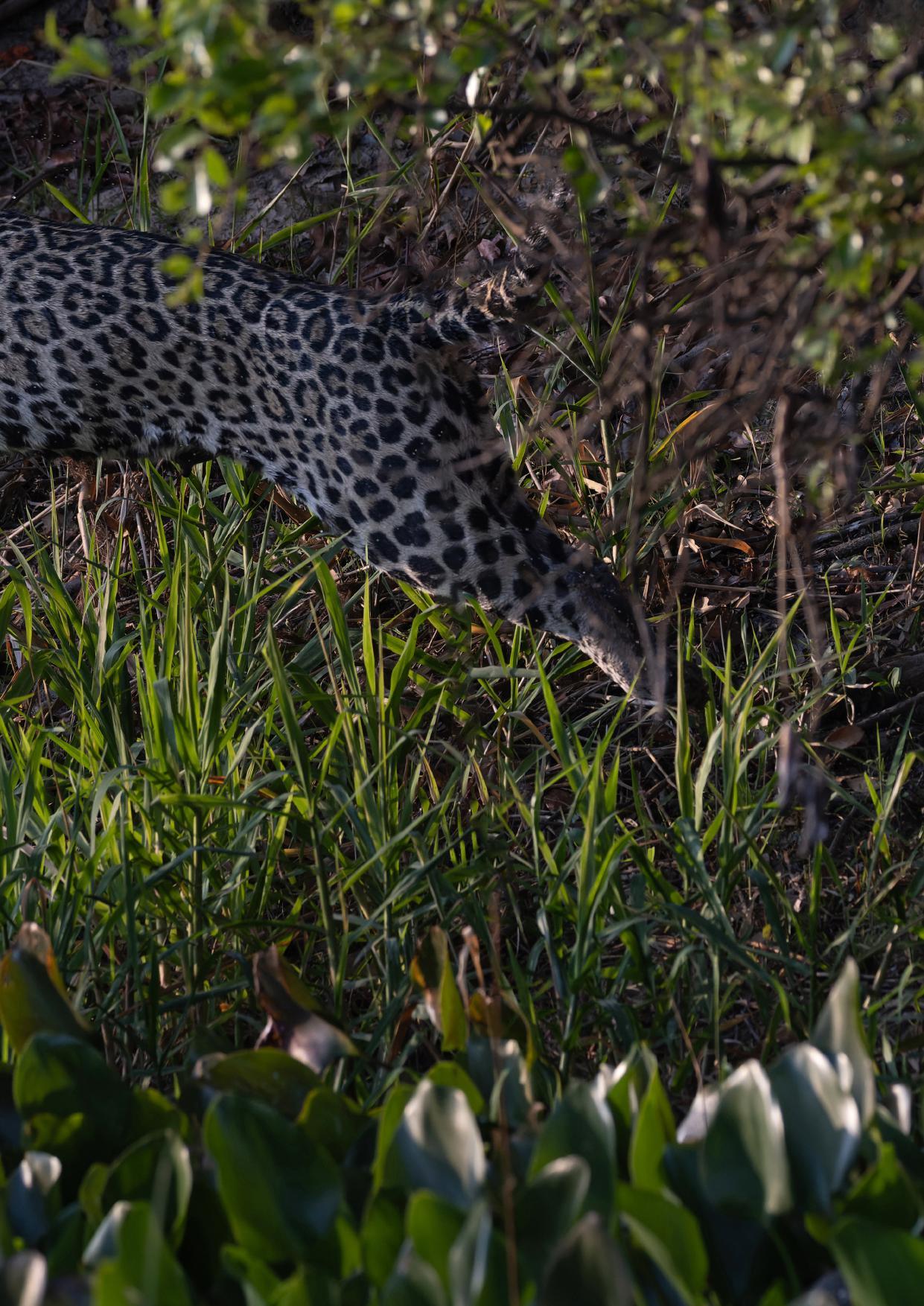


JAGUAR NO. #2 - KRISHNA
Whilst watching Medrosa, another Jaguar was spotted on the opposite bank of the Black Channel.This transpired to be Krishna, the younger step-brother of Medrosa, from Patricia’s 2021 litter. We could watch him walking along the riverbank to where Medrosa had started. He continued into the hinterland away to the southeast and was lost to sight. He is easily identified by the Ace of Spades mark by his left eye.

JAGUAR NO. #3 - MARCELA
After the Krishna sighting, we were called away to another, Jaguar, not far away along the east side of the Rio São Lourenço, just downstream from the Black Channel. Marcela is the 2021 club of Medrosa and shares the same amber eyes and a similar head pattern to her mother and grandmother Patricia. Unfortunately, this encounter was rather dull in comparison to the first two and only involved a bit of walking and swimming.

JAGUAR NO.#4 – GUARACI
Our afternoon boat ride involved another instant Jaguar sighting. Guaraci (since 2021) was another female and was resting in full view on the bank of the Rio Cuiabá under some bushes. She apparently had a kill hidden nearby. After a bout of gluttony, Jaguars need to drink a lot and she eventually made her way to the water’s edge, allowing a nice water-level/ flipscreen opportunity.

JAGUAR NO.#5 – MEDROSA
The first boat ride of day two kicked off with another instant Jaguar sighting. This time Medrosa was sleeping high in a Cambara tree in the Black Channel. Again, a very photogenic setting and we were able to wait until light allowed shooting at faster shutter speeds and
she looked right at us. Some very nice portraits of her beautiful amber eyes.
JAGUAR NO.#6 - BERNARD
As had happened the previous day in the Black Channel, a second Jaguar appeared. This place really is the centre of Jaguar activity! Bernard was not very photogenic, as is sometimes the case with male jaguars. He could be followed by the movement of undergrowth as he powered through it, branches of small trees shaking as he scent-marked them. Bernard has been around since 2018, although his parentage is not recorded. Our 2022 tour saw his cub with the female Jaju.
This page: Polar Bear. Next pages: King
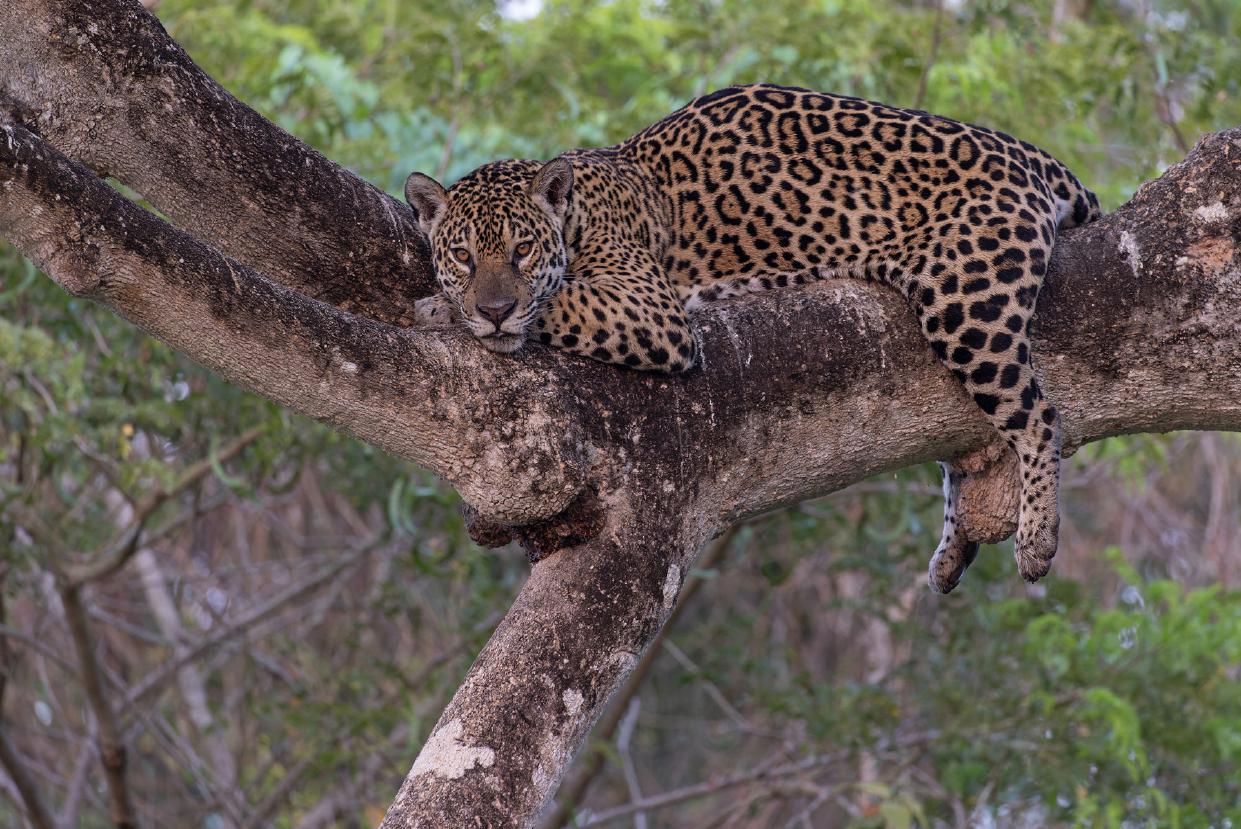


JAGUAR NO.#7 – BORORO
This was our first self-found Jaguar. Bororo was spotted swimming through water hyacinth way upstream on the Rio São Lourenço. After a while he walked out of the water onto a beach before heading into thick vegetation. He was taking a shortcut to the Caxiri channel (the connecting channel between the Rio Cuiabá and Rio São Lourenço), and we were able to pick him up again there as he headed west. An epic series of views followed, as he walked almost the entire length of the channel before veering off, with only around 1 km to go before the Cuiabá. Total beast! He bulldozed through the riverbank vegetation but was rather clumsy and careless when stalking Caymans. A number of them bolted before he got within range. I guess he only bothers with the biggest ones. He did have a go at one, which was dozing under a tree but was always out of jumping range. He is an old friend of ours. We first saw him as one of the ‘brothers’, the twin cubs of Kyra’s third littler, on our 2018 and 2019 tours. His brother Xando was not seen following the 2020 lockdown fires, and it is unknown what happened to him. Bororo is very habituated to boats full of ecotourists, having been brought up in their presence.



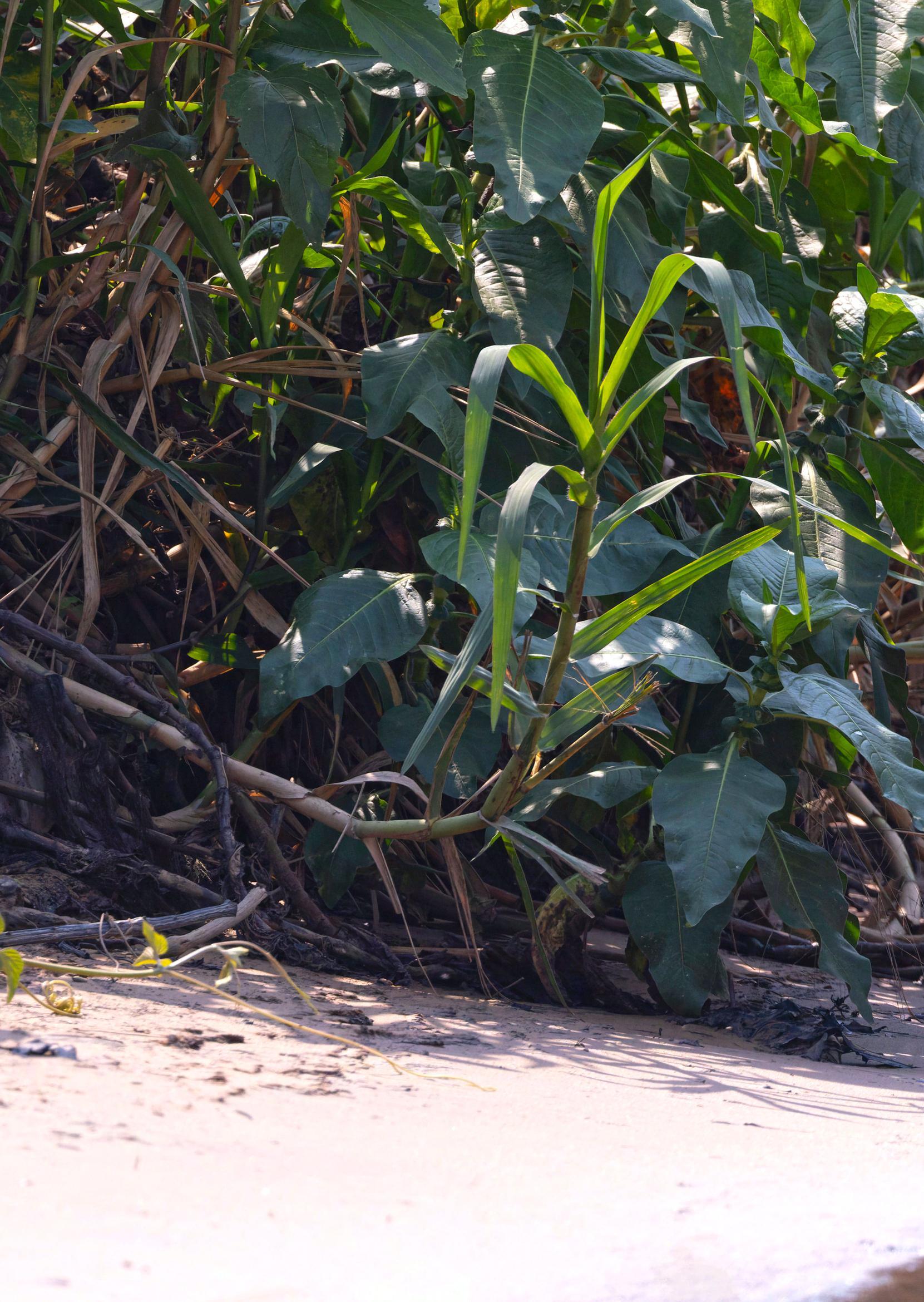




JAGIUAR NO.#8 – GUARACI
Another self-found Jaguar, spotted by Alex, on the way back to Porto Jofre, hunting in riverbank vegetation. She was Jaguar number four from yesterday and caught a small lizard before disappearing.

JAGUAR NO.#9 – PATRICIA
Another self-found Jaguar and probably the best of all. Patricia has been around since 2012 and is the mascot of the Jaguar identification project, as well as being the Wild Images website main image. Very soon after we spotted her, she made her way down a fallen tree, and after lining up a victim, made a huge leap into water hyacinth below, emerging soon after with a 2m long caiman in her jaws. Although we were well-positioned for the leap, the dragging out of the water images were from behind, so I switched to video for those. Patricia is the matriarch of the river, the mother of Medrosa and Krishna, as well, as being the grandmother of Marcela. As often happens, Jaguars take their prey out of sight as quickly as possible, and then go off-line for a couple of days while they stuff themselves.

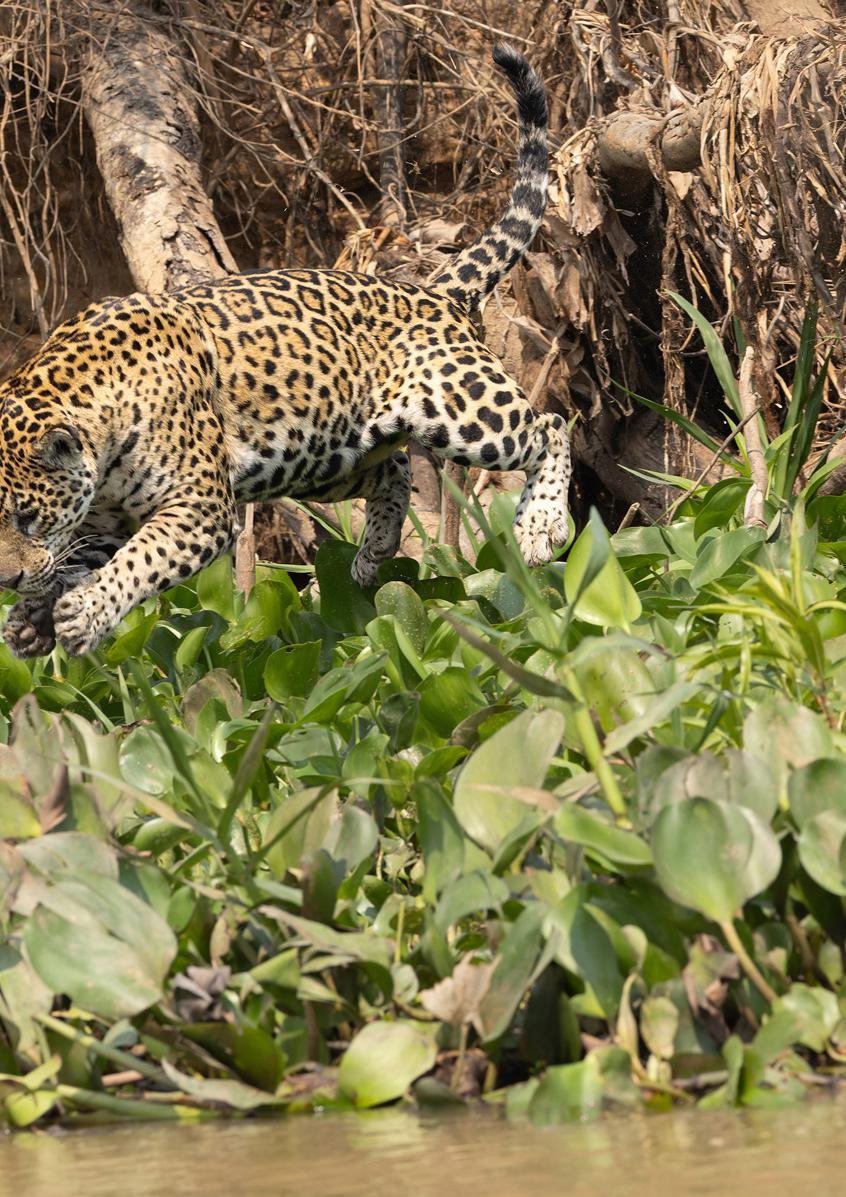
Despite the intense Jaguar activity this morning, no doubt my best session ever, there were still many birds we could photograph, including the familiar herons, Anhinga, Black Skimmer, kingfishers as well as new-for-the-tour Laughing Falcon. A dozen Proboscis Bats were roosting in a tree overhanging the Caxiri Channel and non-avian interest was provided by Black-and-gold Howler Monkey, Capybara and Green Iguana. In the afternoon, we did not target Jaguars after so much success already. Instead, we searched for the Giant Otter family along the Rio Piquiri. They were very active near their communal toilet slide. Very smelly! The adults would carry the young cubs in their jaws up a near vertical in “chimney”, splashing back down into the river with them. A little further upstream, a sandbank held three pairs of Black Skimmer and Pied Plover, the first we had been close to.

JAGUAR NO.#10 – OXUM
Our fourth self-found Jaguar was the seldom-seen female, Oxum, on the bank of the Rio Cuiabá, eating grass before sunrise. Not very photogenic in low light and an uninteresting background, but we managed some head portraits for identification. Keeping up the card theme she bears the Ace of Clubs by her right eye.

JAGUAR NO.#11 – KRISHNA
Krishna turned up again in the hyacinth on the east side of the entrance to the Black Channel, in hunting mode. After working his way along the hyacinth bed, he climbed the riverbank, and almost immediately dropped onto an adult capybara and killed it. It was disturbing to hear the poor animal’s squeals and watch its newly orphaned offspring, swimming away, surely to a similar fate. We eventually managed some good images of Krishna, dragging the poor animal up the steep riverbank and out of sight.
Wild Images | Jaguars of Brazil’s Pantanal 2023 Page 45



JAGUAR NO.#12 – MARCELA
Marcela was seen again on the Rio São Lourenço, in hunting mode, swimming, and walking for some time before disturbing a capybara, which could easily evade her barking from upstream. She also disturbed a young Rufescent Tiger Heron from its nest, which could only fly far enough to plop into the river and it had to swim to the opposite shore to its nest, making its survival even more tricky that it already was. Eventually the disrupter disappeared into the forest, not far from the Black Channel as the Jaguar walks.
Another highlight of this excellent morning session was a Lowland Tapir, swimming at the Rio São Lourenço, just west of the Black Channel inlet, before climbing the riverbank, and heading out of sight stop a giant otter was seen in the Black Channel, on its way somewhere upstream.



Photogenic birds today, included the usual herons, Anhinga and Black-collared Hawk, as well as Large-billed Tern, Turquoise-fronted Amazon, Pale-legged Hornero, Southern Rough-winged Swallows, Black-capped Donacobious. The afternoon session was a blank for Jaguars on the Piquiri that included some nice bird sightings such as Chaco Chachalaca, White-throated Piping Guan, Wood Stork, Jabiru, Plumbeous Ibis, the usual herons, Anhinga and a surprise osprey. Southern Lapwing, Pied Plover and Black Skimmer, as well as Yellow-billed Tern on the sandbanks here. Mammals included Capybara, Azara’s Agouti and Giant Otter.
JAGUAR NO.13 – KRISHNA
An uneventful encounter with Krishna, at the top of the riverbank, sleeping off his capybara.
Birds included some nice opportunities with Boat-billed, and Black-crowned Night Herons, Green and Amazon kingfishers, as well as Orange-winged Amazon parrot. A couple of Brown Capuchin monkeys and a family of Giant Otters along the Piquiri, catching several fish, including a spectacular Snow King Pleco but unfortunately, two of the otters squabbled over it, and did not present it nicely for a photo! Downstream! For the first time ever, I ventured downstream from Porto Jofre to the San Pedrino channel. It was well worth the effort with a host of birds here, notably, the most sought-after Green-and-rufous Kingfisher. It even perched up nicely for photos. There was also a dead buffalo in the channel, which had attracted quite a horde of vultures. We also saw another Sungrebe, and, at last, our first cooperative Striated Herons. In this lovely, quiet inlet, the otter cubs here had clearly not seen many people and were therefore quite shy refusing to follow their parents past our boat. Not far downstream from Porto Jofre is a large mixed tern and skimmer colony, of maybe over 2000 birds, however, the water around it is very shallow and we did not quite do it justice. The outstanding highlight of the return journey was a beautiful Marsh Deer on the Riverbank, easily my nicest encounter with South America’s largest deer.

Wild Images | Jaguars of Brazil’s Pantanal 2023 Page 52

Wild Images | Jaguars of Brazil’s Pantanal 2023 Page 53
Green-and-rufous Kingfisher, San Pedrino Channel, Porto Jofre (Mike Watson)


Wild Images |
of
Pantanal 2023 Page 54
Jaguars
Brazil’s
JAGUAR NO.#14 – MARCELA
Marcela was again sleeping in an overhanging tree on the bank of the Black Channel, and we could wait for her to look directly at us a few times with her beautiful amber eyes. She is instantly identifiable by the notch in her right ear without having to look at those complicated face markings.

JAGUAR NO.#15 –
ALIRA
A new Jaguar for our trip, Alira has been around since 2021. She was eating grass on a beach, well up the Rio Cuiabá, but moved away when more boats arrived. She is the cub of Ti, the caiman-killing female Jaguar of our 2016 tour, and is the litter mate of Guaraci, our Jaguar, numbers four and eight of this tour.
JAGUAR NO.#16
–PATRICIA
We connected with Patricia again this morning, walking along the riverbank from just east of the southern end of the blocked channel of the Rio Cuiabá to the northern end of it, before she disappeared back down it to complete a circle. Some very nice eye-level beach-walking views at times this morning.
JAGUAR NO.#17
– KRISHNA
Krishna was still sleeping off his capybara meal on the riverbank, just east of the Black Channel, rear end on only views/obscured.
We had some great bird encounters today, at last connecting with the diminutive Collared Plover. A pair on the Rio Cuiabá allowed pointblank views on a tiny sandbank, and nearby a very nice eye-level Amazon Kingfisher obliged. White Woodpecker also obliged in some dead trees along the Rio São Lourenço, as did a number Black-backed Water Tyrants and Rusty-margined Flycatchers in the Caxiri Channel. A group of four Black-and-Gold Howler Monkeys included one rather shy male, and a total of three Green Iguanas was seen today, one of which was washed up the bank by our wake before we could go back for it unfortunately.Boat trip number 10 was another afternoon blank for Jaguars, as was becoming a pattern. However, we could spend some time photographing birds again including the usual

Wild Images | Jaguars of Brazil’s Pantanal 2023 Page 55


herons and another Green-and-rufous Kingfisher. White-bellied Seedeater was new for the trip and we saw another three Black-andGold Howler Monkeys and a Giant Otter.

JAGUAR NO.#18 – MARCELA
Marcela was lying on the riverbank near where Krishna had killed the capybara, just east of the entrance to the Black Channel, against the light, and not particularly interesting.
JAGUAR NO.#19 – PATRICIA
Fittingly, our final Jaguar encounter of the 2023 tour was with Patricia. She had visibly been nursing her cubs and was back out hunting again after her caiman kill three days ago. We enjoyed a very prolonged encounter with her, walking the riverbanks of the Cuiabá and São Lourenço, with lots of swimming and jumping over logs, but unfortunately her attempts to catch another caiman were unsuccessful this time.
Bird encounters this morning, included a very nice male Bare-faced Curassow, Boat-billed Herons, and many of the usual species, and at last we connected with Sucuri – Yellow Anaconda, finding two of them downstream towards Porto Jofre in the heat of the day, when they tend to leave the river. Unfortunately, neither was particularly photogenic and one was quite a small animal. Maybe only a couple of metres long, so head shots were the way to go. Still very impressive to see this apex predator, nevertheless.
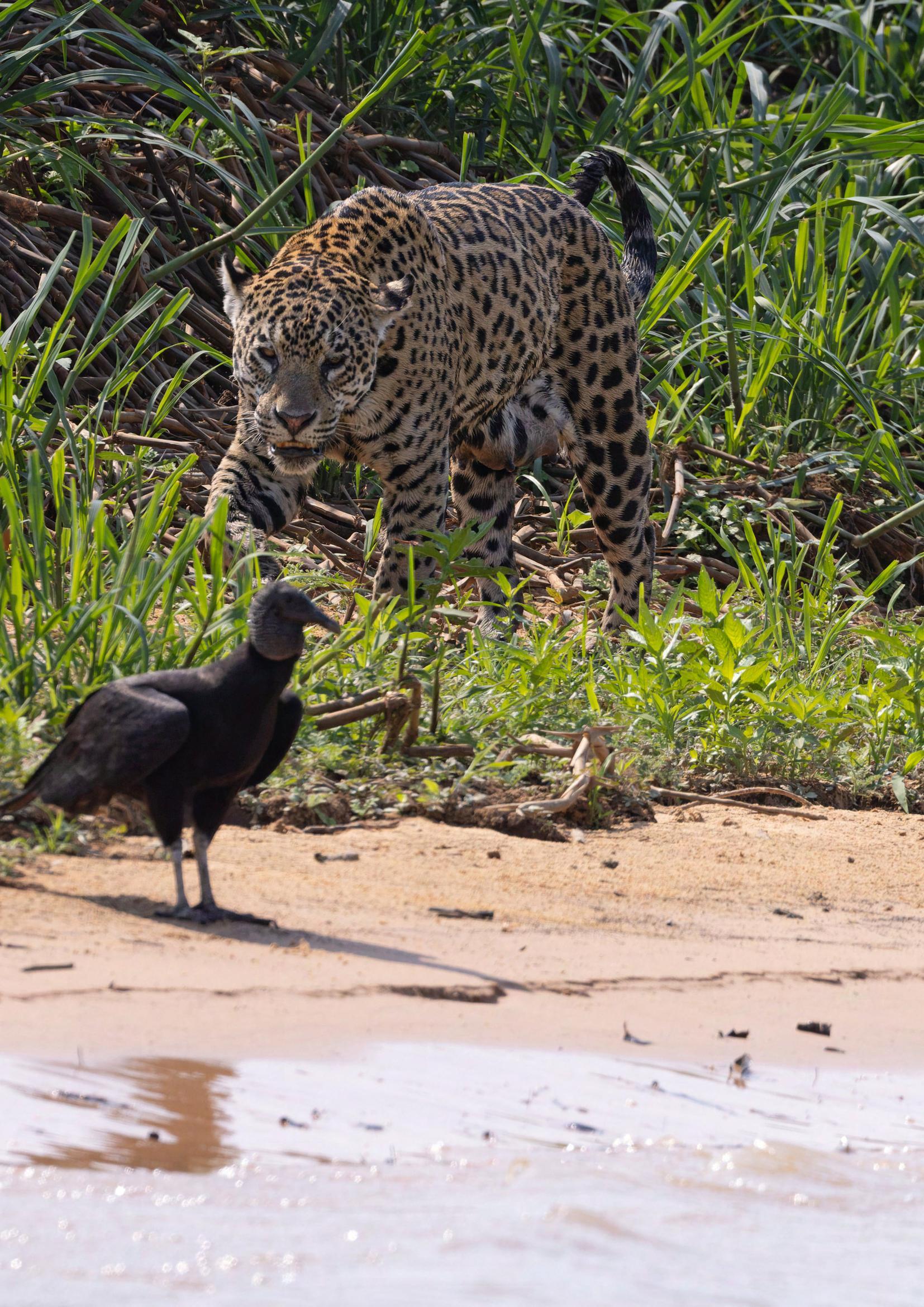



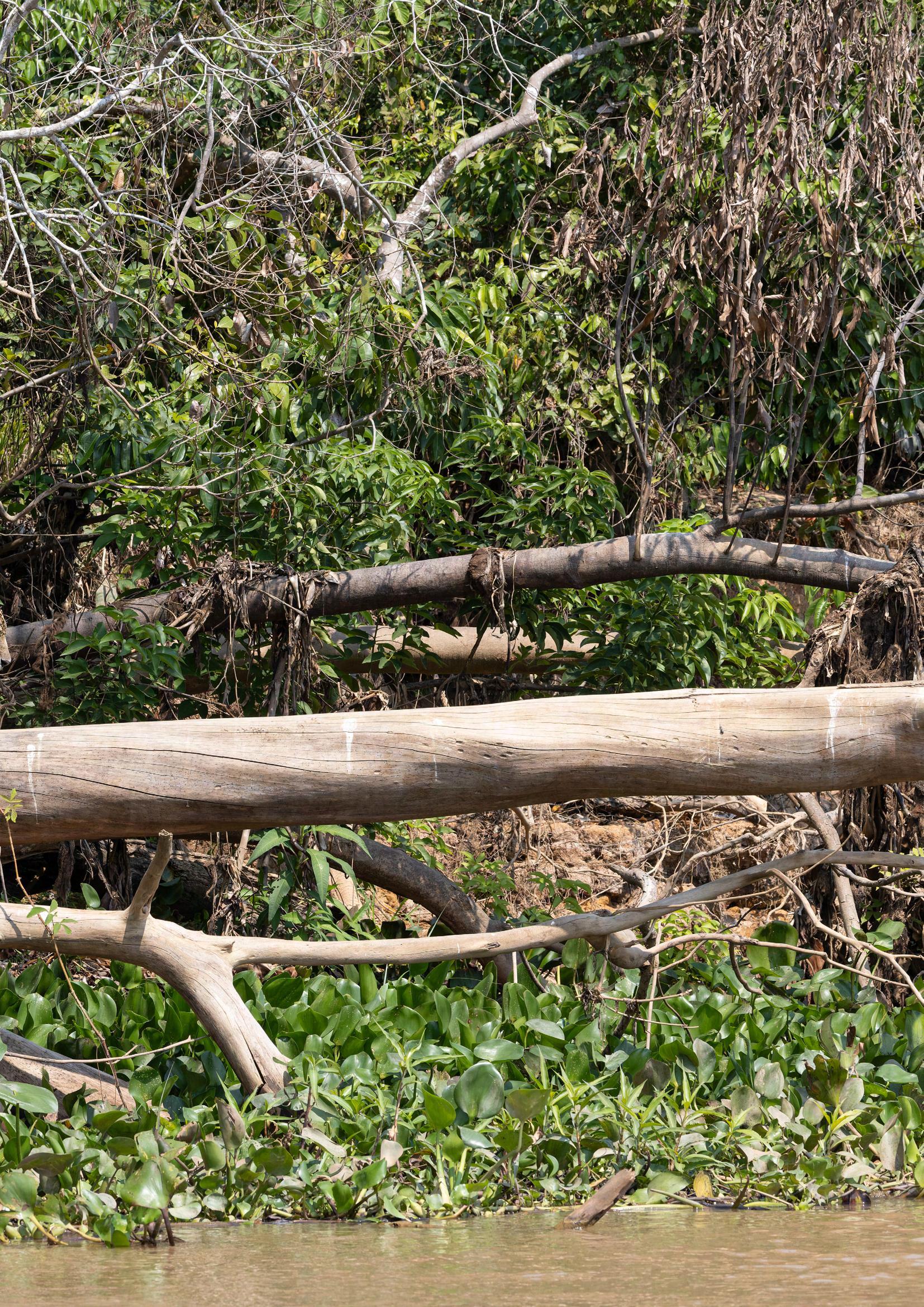
At lunchtime, we said goodbye, temporarily, to KC, off on his Giant Anteater rescue mission with Bianca. They were spectacularly successful, scoring three Giant Anteaters at Pousada Piuval, back up the TP, including a mother, carrying a baby on her back. In contrast, our last boat trip for those who had voted to stay on the river, was dull, yielding only a couple of Crane and Roadside Hawks for the cameras. An early start on our final morning of the tour saw us leaving the Hotel Pantanal Norte after breakfast, and heading back up the TP, where a fortuitous meeting with an old friend of mine. Carlos Sanchez resulted in a Southern Tamandua, high in a roadside tree. Thanks Carlos! Almost a decade after first meeting him in Miami, when he was thinking of guiding as a career. Karma! We picked KC up at Piuval and continued north, seeing a spectacular pair of Red-legged Seriemas by the roadside, including a full-on screaming experience. Dinosaurs are not all dead! A Black-tailed Marmoset crossed the road between Pocone and Varzea Grande before we enjoyed a very nice final lunch by the river, plied with an unlimited number of grilled fish dishes. Eventually, it was time to say goodbye and check in for our various flights.
Thanks to everyone who made our 2023 Brazilian adventure such an enjoyable one, particularly our enthusiastic group, our excellent driver/guide Marlon and our boatmen Dingdong and Alex. We will be back on the river again in 2024. See you there.
2023 Jaguars:
1. Medrosa (female) 22 Aug
2. Krishna (male) 22 Aug
3. Marcela (female) 22 Aug
4. Guaraci (female) 22 Aug
5. Medrosa (female) 23 Aug
6. Bernard (male) 23 Aug
7. Bororo (male) 23 Aug

8. Guaraci (female) 23 Aug
9. Patricia (female) 23 Aug
10. Oxum (female) 24 Aug
11. Krishna (male) 24 Aug
12. Marcela (female) 24 Aug
13. Krishna (male) 25 Aug
14. Marcela (female) 26 Aug
15. Alira (female) 26 Aug
16. Patricia (female) 26 Aug
17. Krishna (male) 26 Aug
18. Marcela (female) 27 Aug
19. Patricia (female) 27 Aug
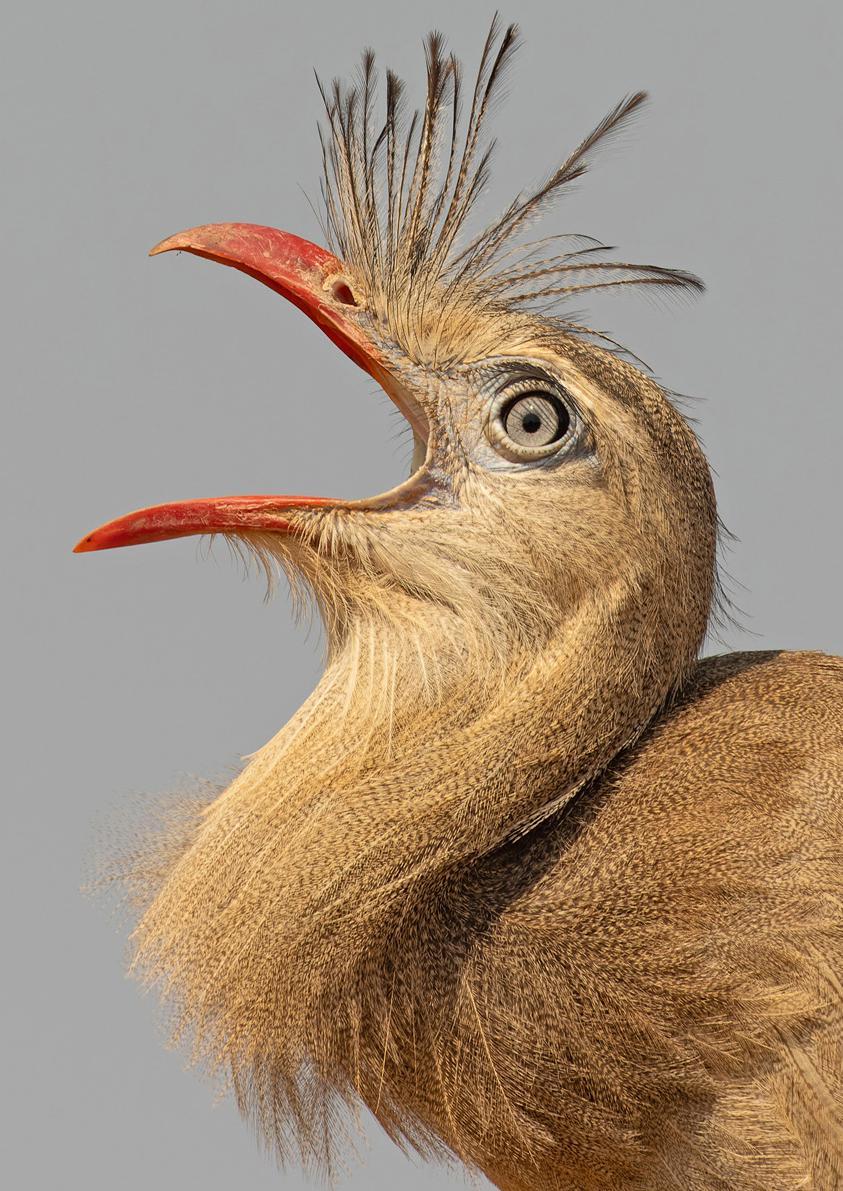 Red-legged Seriema & previous page: Lesser Tamandua (Mike Watson)
Red-legged Seriema & previous page: Lesser Tamandua (Mike Watson)
Pantanal birds. This page: Amazon Kingfisher; Rusty-margined Flycatcher & Black Skimmer. Next page: Pantanal Snipe; Collared Plover & Guira Cuckoo (Mike Watson)


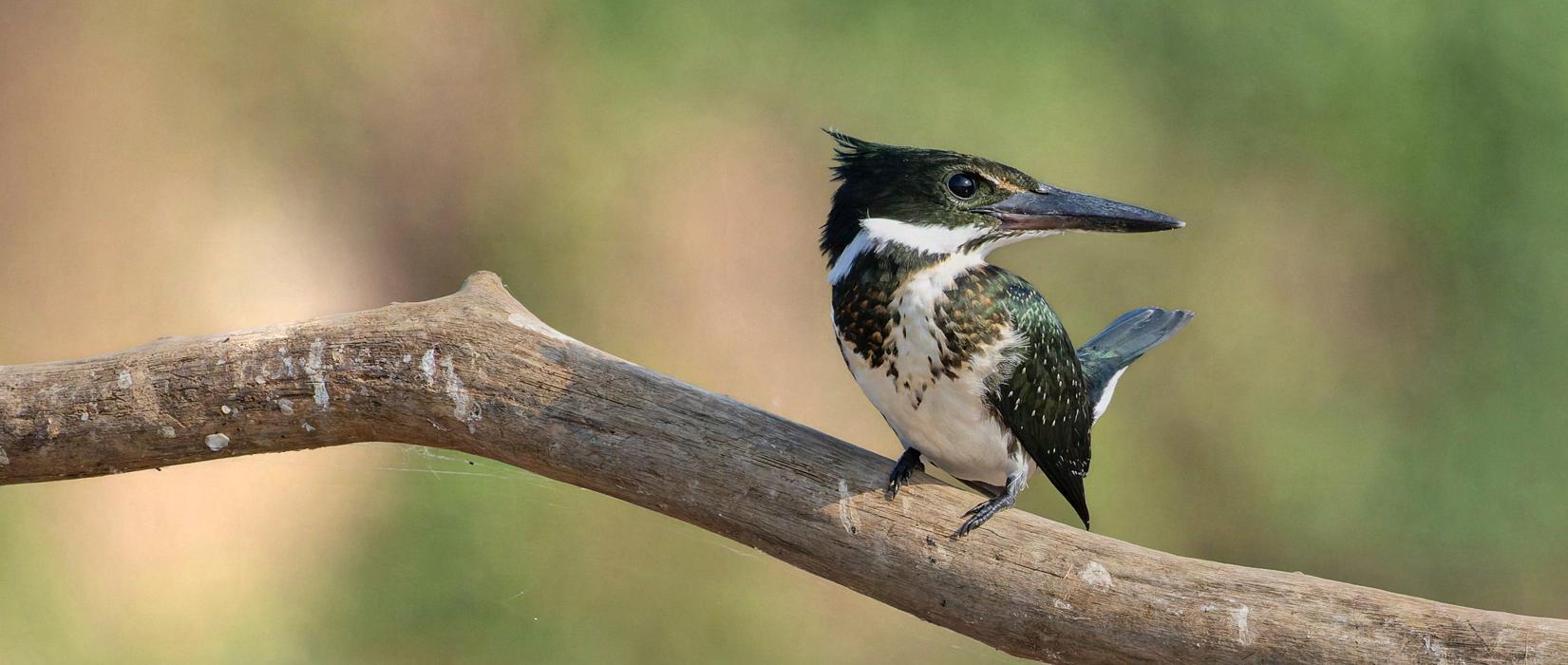

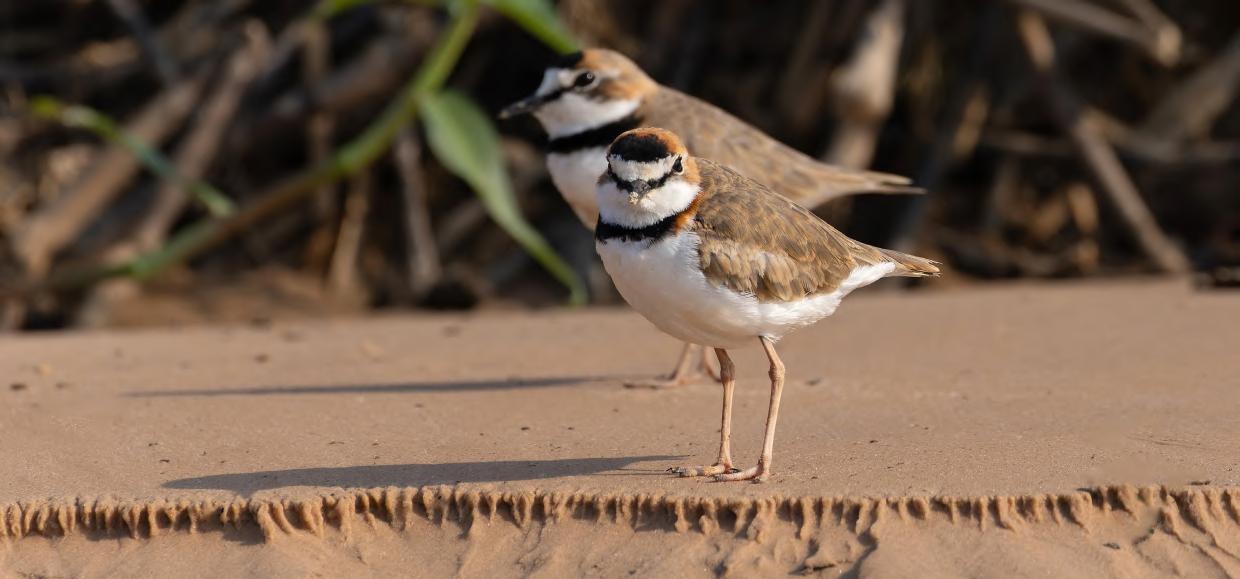


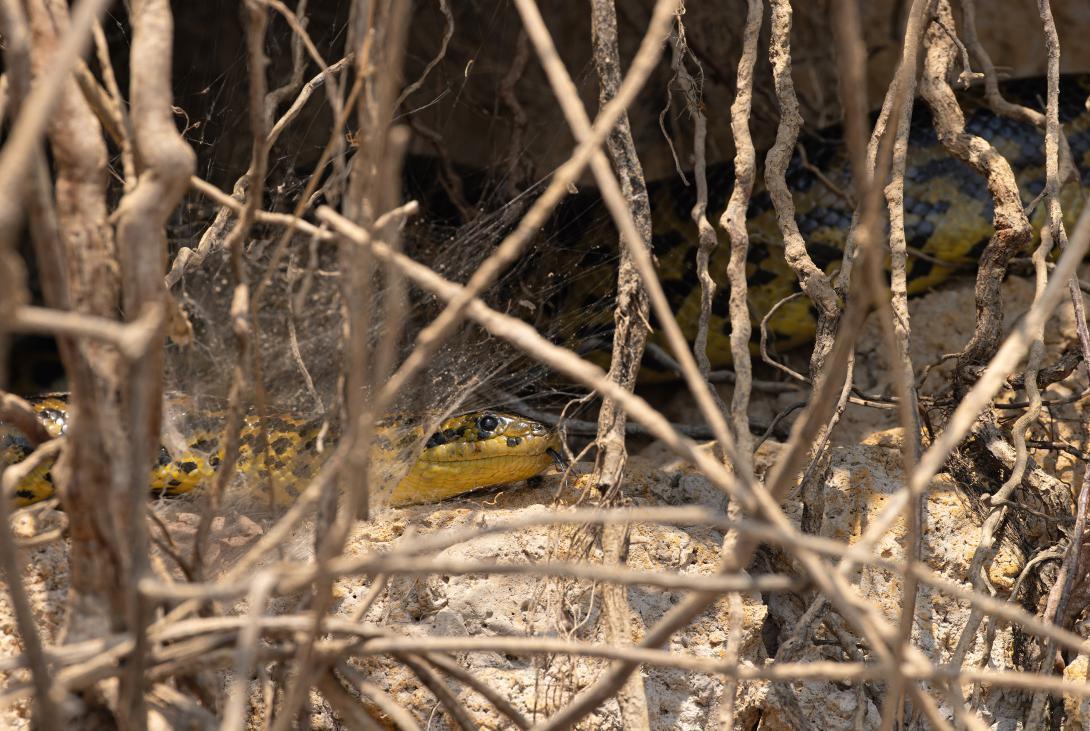
Wild
|
of
2023 Page 68
Images
Jaguars
Brazil’s Pantanal


Wild Images | Jaguars of Brazil’s Pantanal 2023 Page 69

 Sunset Capybara. previous pages: Yellow Anaconda; False Water Cobra & Yacare Caiman (Mike Watson)
Sunset Capybara. previous pages: Yellow Anaconda; False Water Cobra & Yacare Caiman (Mike Watson)












 Agami Heron, SouthWild Santa Tereza. Next page: Boat-billed Heron & Black-collared Hawk (Mike Watson)
Agami Heron, SouthWild Santa Tereza. Next page: Boat-billed Heron & Black-collared Hawk (Mike Watson)








 Hyacinth Macaw. Next pages: Jabirus & Rufescent Tiger Heron (Mike Watson)
Hyacinth Macaw. Next pages: Jabirus & Rufescent Tiger Heron (Mike Watson)





 Lowland Tapir, showing the scars of a life on the riverbank (Mike Watson)
Lowland Tapir, showing the scars of a life on the riverbank (Mike Watson)















































 Red-legged Seriema & previous page: Lesser Tamandua (Mike Watson)
Red-legged Seriema & previous page: Lesser Tamandua (Mike Watson)











 Sunset Capybara. previous pages: Yellow Anaconda; False Water Cobra & Yacare Caiman (Mike Watson)
Sunset Capybara. previous pages: Yellow Anaconda; False Water Cobra & Yacare Caiman (Mike Watson)